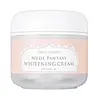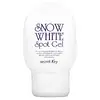What's inside
What's inside
 Key Ingredients
Key Ingredients

 Benefits
Benefits

 Concerns
Concerns

 Ingredients Side-by-side
Ingredients Side-by-side

Water
Skin ConditioningPropanediol
SolventDipropylene Glycol
HumectantCyclopentasiloxane
EmollientGlycereth-26
HumectantCI 77891
Cosmetic ColorantNiacinamide
SmoothingCyclohexasiloxane
EmollientGlycerin
HumectantSodium Acrylate/Sodium Acryloyldimethyl Taurate Copolymer
Emulsion StabilisingDimethicone/Vinyl Dimethicone Crosspolymer
Skin ConditioningDimethicone
EmollientIsohexadecane
EmollientSodium Polyacrylate
AbsorbentHydroxyethyl Acrylate/Sodium Acryloyldimethyl Taurate Copolymer
Emulsion StabilisingDimethiconol
EmollientPhenoxyethanol
PreservativeChlorphenesin
AntimicrobialPolysorbate 80
EmulsifyingEthylhexylglycerin
Skin ConditioningCaprylyl Glycol
EmollientSorbitan Oleate
EmulsifyingGlyceryl Polyacrylate
Parfum
MaskingTriethoxycaprylylsilane
Adenosine
Skin ConditioningDisodium EDTA
Butylene Glycol
HumectantScutellaria Baicalensis Root Extract
AstringentPortulaca Oleracea Extract
Skin ConditioningRosmarinus Officinalis Leaf Extract
AntimicrobialOryza Sativa Extract
AbsorbentTricholoma Matsutake Extract
Skin ConditioningPanax Ginseng Root Extract
EmollientAngelica Keiskei Leaf/Stem Extract
Skin ConditioningArbutin
AntioxidantRumex Crispus Root Extract
Skin ConditioningHippophae Rhamnoides Extract
MaskingMyrciaria Dubia Fruit Extract
Skin ConditioningVanilla Planifolia Fruit Extract
Skin ConditioningLeontopodium Alpinum Extract
Skin ConditioningFreesia Refracta Extract
Skin ConditioningNelumbium Speciosum Flower Extract
Skin ConditioningRose Extract
Skin ConditioningIris Versicolor Extract
EmollientNarcissus Pseudo-Narcissus Flower Extract
Skin ConditioningLilium Tigrinum Extract
Skin ConditioningJasminum Officinale Extract
MaskingWater, Propanediol, Dipropylene Glycol, Cyclopentasiloxane, Glycereth-26, CI 77891, Niacinamide, Cyclohexasiloxane, Glycerin, Sodium Acrylate/Sodium Acryloyldimethyl Taurate Copolymer, Dimethicone/Vinyl Dimethicone Crosspolymer, Dimethicone, Isohexadecane, Sodium Polyacrylate, Hydroxyethyl Acrylate/Sodium Acryloyldimethyl Taurate Copolymer, Dimethiconol, Phenoxyethanol, Chlorphenesin, Polysorbate 80, Ethylhexylglycerin, Caprylyl Glycol, Sorbitan Oleate, Glyceryl Polyacrylate, Parfum, Triethoxycaprylylsilane, Adenosine, Disodium EDTA, Butylene Glycol, Scutellaria Baicalensis Root Extract, Portulaca Oleracea Extract, Rosmarinus Officinalis Leaf Extract, Oryza Sativa Extract, Tricholoma Matsutake Extract, Panax Ginseng Root Extract, Angelica Keiskei Leaf/Stem Extract, Arbutin, Rumex Crispus Root Extract, Hippophae Rhamnoides Extract, Myrciaria Dubia Fruit Extract, Vanilla Planifolia Fruit Extract, Leontopodium Alpinum Extract, Freesia Refracta Extract, Nelumbium Speciosum Flower Extract, Rose Extract, Iris Versicolor Extract, Narcissus Pseudo-Narcissus Flower Extract, Lilium Tigrinum Extract, Jasminum Officinale Extract
Water
Skin ConditioningButylene Glycol
HumectantNiacinamide
SmoothingPropanediol
SolventPEG-60 Hydrogenated Castor Oil
EmulsifyingTrehalose
HumectantCarbomer
Emulsion StabilisingCaprylyl Glycol
EmollientPotassium Hydroxide
BufferingEthylhexylglycerin
Skin ConditioningAloe Barbadensis Leaf Juice
Skin ConditioningAllantoin
Skin ConditioningDipotassium Glycyrrhizate
Humectant1,2-Hexanediol
Skin ConditioningTocopheryl Acetate
AntioxidantPrunus Amygdalus Dulcis Oil
Skin ConditioningSodium Hyaluronate
HumectantCentella Asiatica Extract
CleansingScutellaria Baicalensis Root Extract
AstringentPolygonum Cuspidatum Root Extract
AntioxidantGlycyrrhiza Glabra Root Extract
BleachingCamellia Sinensis Leaf Extract
AntimicrobialChamomilla Recutita Flower Extract
MaskingRosmarinus Officinalis Leaf Extract
AntimicrobialDisodium EDTA
Parfum
MaskingWater, Butylene Glycol, Niacinamide, Propanediol, PEG-60 Hydrogenated Castor Oil, Trehalose, Carbomer, Caprylyl Glycol, Potassium Hydroxide, Ethylhexylglycerin, Aloe Barbadensis Leaf Juice, Allantoin, Dipotassium Glycyrrhizate, 1,2-Hexanediol, Tocopheryl Acetate, Prunus Amygdalus Dulcis Oil, Sodium Hyaluronate, Centella Asiatica Extract, Scutellaria Baicalensis Root Extract, Polygonum Cuspidatum Root Extract, Glycyrrhiza Glabra Root Extract, Camellia Sinensis Leaf Extract, Chamomilla Recutita Flower Extract, Rosmarinus Officinalis Leaf Extract, Disodium EDTA, Parfum
Ingredients Explained
These ingredients are found in both products.
Ingredients higher up in an ingredient list are typically present in a larger amount.
Butylene Glycol (or BG) is used within cosmetic products for a few different reasons:
Overall, Butylene Glycol is a safe and well-rounded ingredient that works well with other ingredients.
Though this ingredient works well with most skin types, some people with sensitive skin may experience a reaction such as allergic rashes, closed comedones, or itchiness.
Learn more about Butylene GlycolCaprylyl Glycol is a humectant and emollient, meaning it attracts and preserves moisture.
It is a common ingredient in many products, especially those designed to hydrate skin. The primary benefits are retaining moisture, skin softening, and promoting a healthy skin barrier.
Though Caprylyl Glycol is an alcohol derived from fatty acids, it is not the kind that can dry out skin.
This ingredient is also used as a preservative to extend the life of products. It has slight antimicrobial properties.
Learn more about Caprylyl GlycolDisodium EDTA plays a role in making products more stable by aiding other preservatives.
It is a chelating agent, meaning it neutralizes metal ions that may be found in a product.
Disodium EDTA is a salt of edetic acid and is found to be safe in cosmetic ingredients.
Learn more about Disodium EDTAEthylhexylglycerin (we can't pronounce this either) is commonly used as a preservative and skin softener. It is derived from glyceryl.
You might see Ethylhexylglycerin often paired with other preservatives such as phenoxyethanol. Ethylhexylglycerin has been found to increase the effectiveness of these other preservatives.
Niacinamide is a multitasking form of vitamin B3 that strengthens the skin barrier, reduces pores and dark spots, regulates oil, and improves signs of aging.
And the best part? It's gentle and well-tolerated by most skin types, including sensitive and reactive skin.
You might have heard of "niacin flush", or the reddening of skin that causes itchiness. Niacinamide has not been found to cause this.
In very rare cases, some individuals may not be able to tolerate niacinamide at all or experience an allergic reaction to it.
If you are experiencing flaking, irritation, and dryness with this ingredient, be sure to double check all your products as this ingredient can be found in all categories of skincare.
When incorporating niacinamide into your routine, look out for concentration amounts. Typically, 5% niacinamide provides benefits such as fading dark spots. However, if you have sensitive skin, it is better to begin with a smaller concentration.
When you apply niacinamide to your skin, your body converts it into nicotinamide adenine dinucleotide (NAD). NAD is an essential coenzyme that is already found in your cells as "fuel" and powers countless biological processes.
In your skin, NAD helps repair cell damage, produce new healthy cells, support collagen production, strengthen the skin barrier, and fight environmental stressors (like UV and pollution).
Our natural NAD levels start to decline with age, leading to slower skin repair, visible aging, and a weaker skin barrier. By providing your skin niacinamide, you're recharging your skin's NAD levels. This leads to stronger, healthier, and younger looking skin.
Another name for vitamin B3 is nicotinamide. This vitamin is water-soluble and our bodies don't store it. We obtain Vitamin B3 from either food or skincare. Meat, fish, wheat, yeast, and leafy greens contain vitamin B3.
The type of niacinamide used in skincare is synthetically created.
Learn more about NiacinamideParfum is a catch-all term for an ingredient or more that is used to give a scent to products.
Also called "fragrance", this ingredient can be a blend of hundreds of chemicals or plant oils. This means every product with "fragrance" or "parfum" in the ingredients list is a different mixture.
For instance, Habanolide is a proprietary trade name for a specific aroma chemical. When used as a fragrance ingredient in cosmetics, most aroma chemicals fall under the broad labeling category of “FRAGRANCE” or “PARFUM” according to EU and US regulations.
The term 'parfum' or 'fragrance' is not regulated in many countries. In many cases, it is up to the brand to define this term.
For instance, many brands choose to label themselves as "fragrance-free" because they are not using synthetic fragrances. However, their products may still contain ingredients such as essential oils that are considered a fragrance by INCI standards.
One example is Calendula flower extract. Calendula is an essential oil that still imparts a scent or 'fragrance'.
Depending on the blend, the ingredients in the mixture can cause allergies and sensitivities on the skin. Some ingredients that are known EU allergens include linalool and citronellol.
Parfum can also be used to mask or cover an unpleasant scent.
The bottom line is: not all fragrances/parfum/ingredients are created equally. If you are worried about fragrances, we recommend taking a closer look at an ingredient. And of course, we always recommend speaking with a professional.
Learn more about ParfumPropanediol is an all-star ingredient. It softens, hydrates, and smooths the skin.
It’s often used to:
Propanediol is not likely to cause sensitivity and considered safe to use. It is derived from corn or petroleum with a clear color and no scent.
Learn more about PropanediolRosmarinus Officinalis Leaf Extract comes from rosemary. Rosemary is native to the Mediterranean.
While Rosmarinus Officinalis Leaf Oil can be volatile due to its fragrant properties, the fragrance components are usually removed in the leaf extract.
Rosemary Leaf Extract contains many antioxidants such as rosmarinic acid and caffeic acid. Rosemarinic acid, a compound found in rosemary leaf, has been found to help soothe skin conditions such as eczema and acne.
Learn more about Rosmarinus Officinalis Leaf ExtractScutellaria Baicalensis Root Extract comes from the Baikal skullcap or Chinese skullcap plant. This plant is native to Northeast Asia and can be found in China, Mongolia, Korea, and Siberia.
In cosmetics, Scutellaria Baicalensis Root Extract provides antioxidant and anti-inflammatory benefits. This is due to the flavonoid composition of Scutellaria Baicalensis Root Extract.
In Chinese traditional folk medicine, Scutellaria Baicalensis Root Extract is used to help treat lung issues and hypertension.
Learn more about Scutellaria Baicalensis Root ExtractWater. It's the most common cosmetic ingredient of all. You'll usually see it at the top of ingredient lists, meaning that it makes up the largest part of the product.
So why is it so popular? Water most often acts as a solvent - this means that it helps dissolve other ingredients into the formulation.
You'll also recognize water as that liquid we all need to stay alive. If you see this, drink a glass of water. Stay hydrated!
Learn more about Water